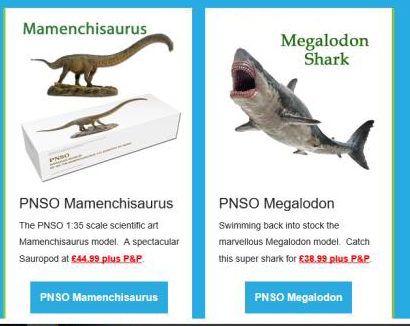New PNSO Prehistoric Animal Models
New PNSO Prehistoric Animal Models Debut in Everything Dinosaur Newsletter
The latest Everything Dinosaur newsletter was published this week and it featured the new PNSO Age of Dinosaurs models as well as a couple of old favourites. Just in at the warehouse, the giant “Nick” the Ceratosaurus figure, “Brook” the Ophthalmosaurus along with a 1:35 scale Mamenchisaurus and all twenty-four of the new for 2019 PNSO Toys that Accompany your Growth model series.
To view the new for 2019 PNSO Age of Dinosaurs figures including the new Ceratosaurus: PNSO Age of Dinosaurs.
The Huge PNSO Ceratosaurus Model Headlines the Everything Dinosaur Spring Newsletter
Picture credit: Everything Dinosaur
The PNSO Age of Dinosaurs Ceratosaurus
This is a huge model, the box alone measures more than half a metre in length. The model inside is enormous and it deserves top billing in our spring newsletter. The figure is beautifully painted and depicts this Late Jurassic theropod in an aggressive pose with one foot raised off the ground. The model is supplied with two supports to help it to be displayed. It towers over other theropod dinosaur models.
The PNSO Ceratosaurus “Nick” Dinosaur Model
Ophthalmosaurus Swims into View
The eagerly awaited PNSO Ophthalmosaurus has also arrived and it features in the newsletter too. A number of academics, palaeontologists and other scientists have made enquiries about PNSO replicas. The Ophthalmosaurus replica for example, will be used in science communications work. As well as sending out the newsletter to our subscribers, team members were busy ensuring that all those customers who had requested one of these models was contacted.
The PNSO Ophthalmosaurus Figure Swims into Stock at Everything Dinosaur
Picture credit: Everything Dinosaur
A New Mamenchisaurus Plus the Return of Megalodon and Basilosaurus
PNSO have created a 1:35 scale model of Mamenchisaurus, an iconic sauropod from China that had the longest neck relative to its body of any known member of the Sauropoda. Mamenchisaurus had nineteen cervical vertebrae and the neck of this twenty-one metre monster measured a whopping fourteen metres or so. It features in the Everything Dinosaur newsletter alongside a returning favourite, the PNSO Megalodon shark model is back in stock.
The PNSO 1:35 Scale Mamenchisaurus and the Return of the Megalodon

Picture credit: Everything Dinosaur
PNSO T. rex “Wilson”, Triceratops “Doyle” and the Small Prehistoric Animal Figures
It can’t really be an Everything Dinosaur newsletter without one mention of Tyrannosaurus rex. The 1/35 th scale T. rex called “Wilson” is back in stock along with its counterpart, the magnificent Triceratops “Doyle” which has been modelled in the same scale.
Also just arrived at Everything Dinosaur, are the latest editions to the PNSO small prehistoric animal model range. The set includes twenty-four, beautifully sculpted little prehistoric animal figures in the PNSO Toys that Accompany your Growth series. In the image, that we created for our spring newsletter, only fourteen of the twenty-four models were depicted, but this is enough to give model collectors a good idea of the breadth and the quality of this exciting replica series.
Mini Prehistoric Animals and a Special Offer for Newsletter Subscribers

Picture credit: Everything Dinosaur
Visit the Everything Dinosaur website: Everything Dinosaur.
Everything Dinosaur newsletter subscribers are amongst the first to learn about new models and replicas coming into stock. Subscribers can also be the first to join a VIP reserve list to ensure that they can acquire items. Our newsletter is sent out periodically and it is absolutely free to join.
A spokesperson from Everything Dinosaur commented:
“We are delighted to welcome more of the amazing PNSO prehistoric animal models into our company”
To request to join the Everything Dinosaur newsletter subscribers list: Simply Email Everything Dinosaur.





























